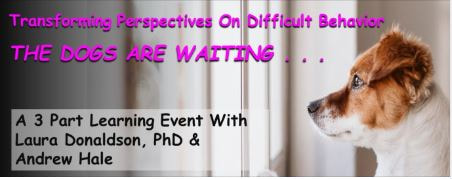Laura Donaldson - PhD, CDBC, KPA CTP, Certified Dog Behavior Consultant,
IAABC Karen Pryor Academy Certified Training Partner.
IAABC Karen Pryor Academy Certified Training Partner.
THE IMPORTANCE OF BECOMING TRAUMA-INFORMED!!!©
Good Intentions Are Not Enough . . . .
Featured Courtesy of Laura Donaldson - ©
https://www.facebook.com/ledonaldson & www.fourpawsfourdirections.com
Good Intentions Are Not Enough . . . .
Featured Courtesy of Laura Donaldson - ©
https://www.facebook.com/ledonaldson & www.fourpawsfourdirections.com
(unfortunately we do not have access to video link, so have pinned the video to the top of our Facebook page until 18.10.22)
thereafter you can scroll down to when originally shared – 10th October 22 to view the video)
thereafter you can scroll down to when originally shared – 10th October 22 to view the video)
This video clip says it all: this Beagle is one of the 400+ rescued from a U.S. breeding facility supplying various North American laboratories. My assumption is that this is very early in his/her rescue when the dog was being transported off site. The human stroking and speaking to the dog has every good intention--her strokes are gentle and her voice is soft. In spite of the human's obvious good intentions, however, the interaction (however kind-hearted) is re-traumatizing this dog. Why would I conclude this?--because the dog has gone into a freeze mode that is frequently identified as TONIC IMMOBILITY. There is almost no eye or muscle movement and the dog has chosen to face away from the direction of any human interaction. There are flecks of foam on the dog's lips and if you watch the video closely, you will see the drool dripping from his/her mouth. FREEZE DOES NOT EQUAL CALMNESS! Instead, it reveals a body language of deep-seated fear, emotional paralysis and the lack of coping mechanisms that would enable this small Beagle to navigate the rescue situation calmly.
SO WHAT SHOULD ONE DO? First and foremost, this dog needs to experience what I call DEEP SAFETY. In order to feel safe, he/she needs some control over what is happening, including any human interactions. In the video clip, the dog's body language is crying out that human stroking is not safe but rather, dangerous. The failure of the well-intentioned human to recognize this is a failure repeated by many involved in the rescue world--and also in the larger world of dog training. A better choice for this dog would have been to respect his/her physical boundaries, let them say when they are ready to interact with a human and even put a visual barrier over the crate. Becoming trauma-informed is not hard, although it can upend some commonly received wisdom like if a dog is scared, comfort them through physical interaction. A trauma-informed approach to rescue (or any dog for that matter) just takes the will to embrace and enable this education on the part of organizations and individual people. Keep the canine faith!!!!
SO WHAT SHOULD ONE DO? First and foremost, this dog needs to experience what I call DEEP SAFETY. In order to feel safe, he/she needs some control over what is happening, including any human interactions. In the video clip, the dog's body language is crying out that human stroking is not safe but rather, dangerous. The failure of the well-intentioned human to recognize this is a failure repeated by many involved in the rescue world--and also in the larger world of dog training. A better choice for this dog would have been to respect his/her physical boundaries, let them say when they are ready to interact with a human and even put a visual barrier over the crate. Becoming trauma-informed is not hard, although it can upend some commonly received wisdom like if a dog is scared, comfort them through physical interaction. A trauma-informed approach to rescue (or any dog for that matter) just takes the will to embrace and enable this education on the part of organizations and individual people. Keep the canine faith!!!!





